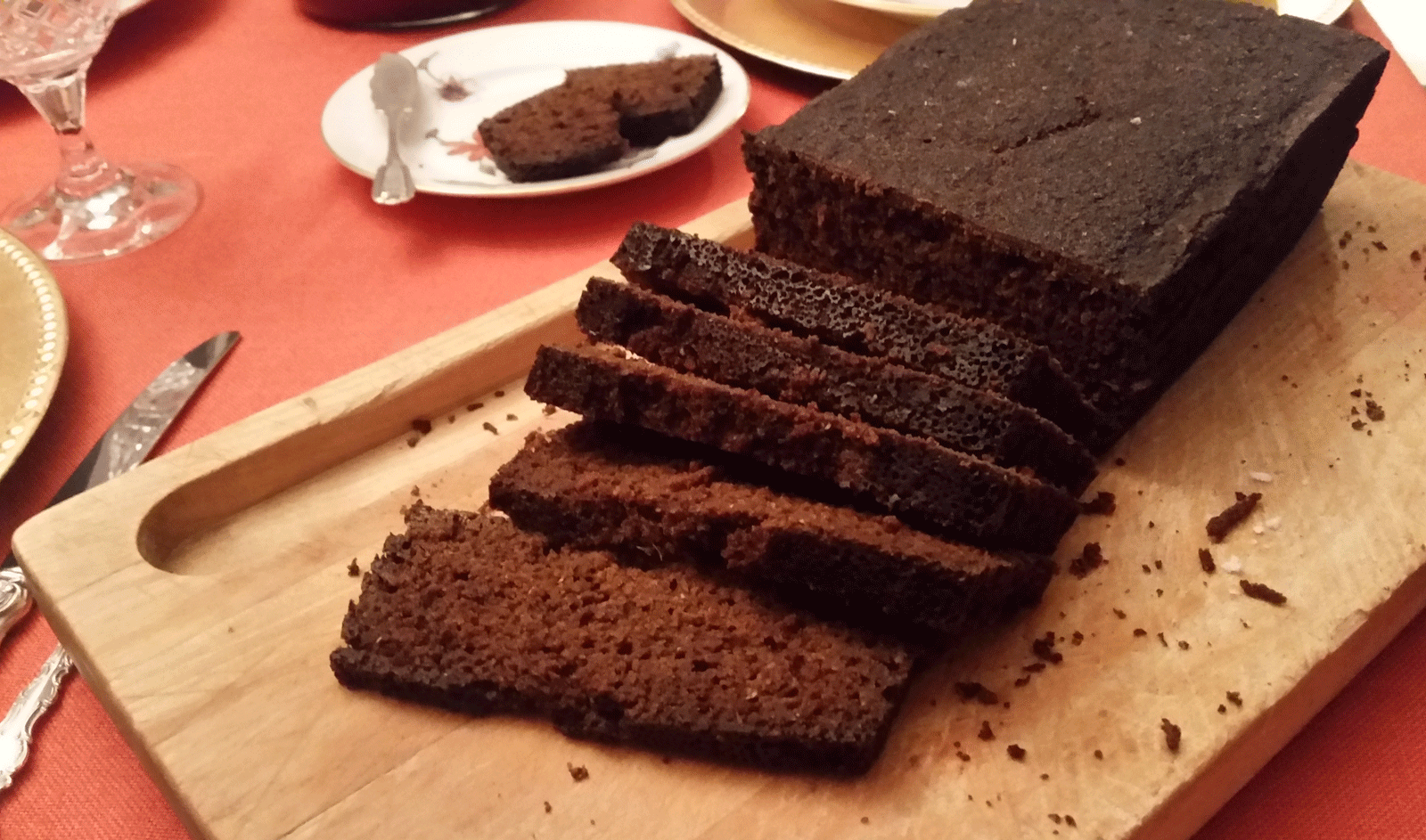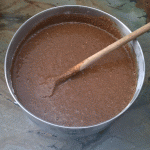| Rye %: | 41% |
| Stages: | Straight dough |
| Leaven: | Baking soda |
| Start to Finish: | 5½ hours |
| Hands-on Time: | 20-30 minutes |
| Yield: | Two 2 lb./900 g loaves |
For me, Thanksgiving is always a time for celebrating New England’s food traditions. There’s turkey, of course, which roamed the deciduous forests of the Northeast; pumpkin and corn, mainstays of the Native Americans’ diet; and West Indies molasses, which came to the colonies via Britain’s system of triangular trade.
The first Europeans brought rye, which they mixed with cornmeal to make Rye and Indian Bread; later, the addition of molasses and wheat flour transformed the coarse loaf into Boston Brown Bread, which has become the benchmark New England loaf, to the exclusion of all others.
So I was both surprised and pleased to find another New England heirloom rye-and-corn bread, Rhode Island Brown Bread, in the 1887 edition of The White House Cookbook by F. L. Gillette and Hugo Ziemann.
One quick look at the formula and its lineage becomes obvious: this is another descendant of Rye and Indian Bread. Both the Boston and Rhode Island versions Both breads contain large quantities of molasses – over half the total flour weight, and both bake low and slow, producing a deeply caramelized chestnut-brown crumb. Unlike its Bostonian cousin, however, Rhode Island Brown Bread contains no wheat but does include one egg and a pinch of cream of tartar to augment the natural acidity of the molasses. And at a hydration level of over 160%, as compared with around 100% for the Boston version, it starts out as a runny batter that, frankly, I wasn’t sure would ever turn into a firm loaf.
The finished bread is both rustic and luxurious: the coarsely ground cornmeal – I used yellow heirloom cornmeal from Geechie Boy Mill in Edisto, South Carolina – combines with the fine rye meal to produce a pleasing grainy texture, while the interplay of corn, rye and molasses yields a sweet-spicy-musky flavor profile. We had it for Thanksgiving, where its assertive flavor stood up nicely against the cranberry relish, candied yams and smoked turkey that are traditional in our home. The morning after, I had it for breakfast with a schmear of cream cheese. Delicious!!
Final Dough:
| Ingredient |
Grams |
Ounces |
Baker’s |
| Cornmeal |
400 |
14.10 |
59.26% |
| Fine rye meal |
275 |
9.70 |
40.74% |
| Whole milk |
985 |
34.75 |
145.93% |
| Salt |
12 |
0.40 |
1.78% |
| Egg, one large |
50 |
1.75 |
7.41% |
| Unsulphured molasses |
340 |
12.00 |
50.37% |
| Cream of tartar |
6 |
0.20 |
0.89% |
| Baking soda |
4 |
0.15 |
0.59% |
| TOTAL FORMULA |
2,072 |
73.05 |
306.96% |
| TOTAL FLOUR |
675 |
23.80 |
100.00% |
Combine the final dough ingredients and mix by hand into a loose batter.
Pour the batter into two well-greased 8½”x4½”/23×12 cm loaf pans, filling them until they’re about ¾ full. Cover tightly with aluminum foil.
Preheat the oven to 200F/93C and bake for 5 hours. Let cool in the pan before slicing.




Mary Beth
December 3, 2016Wow! This looks delicious. I love these kinds of steamed/”quick” breads. Have you ever just baked them in a (lidded) Pullman loaf tin? I used one quite a while ago and it worked well for a Boston brown bread.
Stanley Ginsberg
December 3, 2016I haven’t tried the Pullman pans. My sense is that the cover doesn’t seal as well as aluminum foil and so I prefer to go for the tighter seal, which I think produces a moister bread … although I will say that with the amount of molasses in both the Rhode Island and Boston brown breads, dryness isn’t likely to be a problem. Maybe I’ll give it a shot next time around. Thanks for your comment.
Marilyn F.
December 3, 2016Very interesting. When I saw your recipe was from the White House Cookbook, I knew I had a copy of it. I found my grandmother’s WHC published in 1926 and then another published in 1890 – an Estate find. Both copies have this recipe in it, but not with as many details as yours, which is very helpful. I don’t know how often these cookbooks were published, but I feel lucky to have two of them. Thank you.
Stanley Ginsberg
December 3, 2016I have the same version as you; I just converted the volumes into both grams and ounces and used the same 200F baking temperature I use for Boston Brown Bread, only for the 5 hours TWHCB specifies.
Marilyn F.
December 4, 2016Its great to have your updated recipe and the history you spoke of behind it. It all makes the recipe a complete package. Thanks!